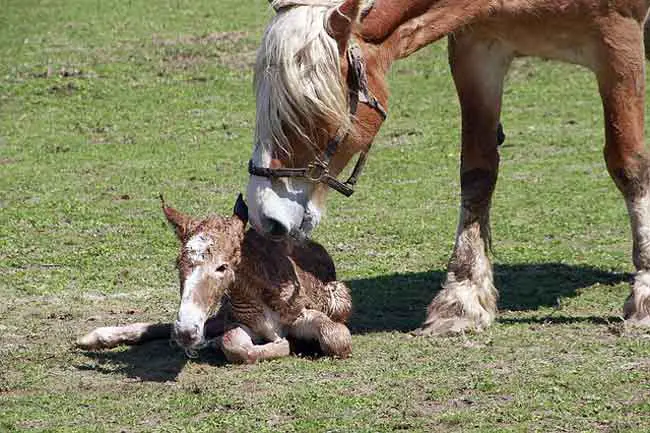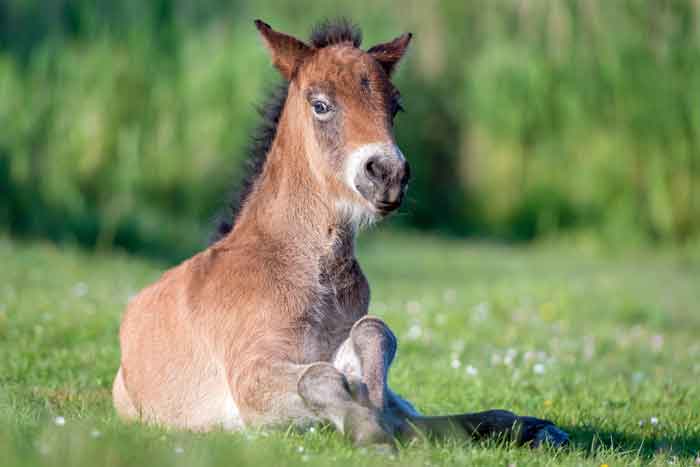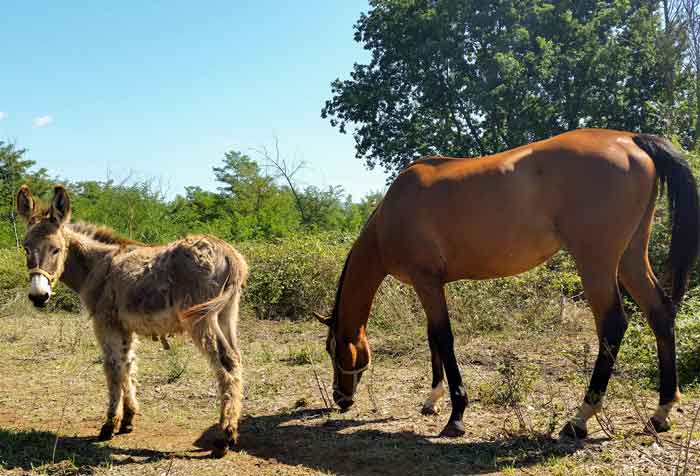You might be wondering if female horses (mares) have periods. Let’s take a look at how it works compared to humans and compared to other animals.
Do Female Horses Have Periods?
Female horses (Mares) do not have periods like humans. They do have an Estrous Cycle also known as Heat. It takes around 19-22 days and it starts in the early season of the spring. They only cycle this one time per year.
Here’s what you need to know about the cycle of a Mare
Table of Contents
What Does Estrous Cycles Look Like For Mares?
The “period” of a female horse (a Mare) has many names. They are most typically referred to as the “season” or “heat”.
It typically takes between 19 and 22 days and it starts in early spring. During the rest of the year, they are in the. We call “anestrus” which is the period where she can not get pregnant.
This is important because you don’t want the horse to give birth to a foal during the winter months. This can be dangerous to both the mother and the newborn foal. The weather is simply too cold for the mother to sustain the little one and it wouldn’t work out.
The foal will have a much better chance of surviving during the nice warm weather of the spring and the summer.
Here’s exactly what happens (in layman’s terms):
- The days are getting longer and the mare gets more light from the sun. This starts the circle.
- The horse goes into “Proestrus” during which a follicle is starting to grow in the ovary. The follicle is a little sack that protects the precious little egg.
- Estrus starts now and that’s when the follicle grows much bigger.
- Here’s the best time to breed with the stallion.
- After a while, the eggs are released. It should already be fertilized at this point. Otherwise, the egg til be spilled.
- Now Metestrus begins where the egg travels toward the uterus.
- Here it will grow until the foal is born.
Do Horses Bleed During Their Period?
The female horse does not bleed during the cycle.
So you don’t need to worry about the floor getting dirty or filled with blood. And this is not the way to find out whether she’s having her cycle or not. Instead, you should always assume that the mare is having her cycle at the beginning of the spring.
The female horse follows a very specific pattern so you don’t need to speculate. As soon as the days are getting longer and she is exposed to more light during the day she will start her cycle.
This happens all naturally and there’s nothing you should do to stop it or start it.
This is actually something that can be provoked by exposing the mare to more light. This is quite common as horse breeders want to get the little ones out very early in the year. When the mare gets pregnant around February it will typically give birth to the foal around January next year.
At What Age Can The Female Horse Reproduce?

The mare will start having its cycle from the age of two and the owner will often start breeding immediately. When the mare turns three they are typically no longer referred to as a “Filly” but as a Mare.
A young mare should not be bred until the age of four or five because this is the age where they have fully developed their bodies. This leaves them with better chances of a healthy pregnancy.
Now that the mayor is fully grown it can produce a foal per year until she is in her twenties. This leaves plenty of time to have a good deal of foals so there’s typically no rush to get started before the age of four or five.
Can You Ride A Pregnant Horse?
You can ride a mare during the full length of her pregnancy. During the last 3 months, you should make sure not to push her and you should make sure she doesn’t get exhausted. Regular exercise will leave her in better shape to be ready for giving birth to the foal.
You can easily write a mare at the beginning of the pregnancy but as the little foal matures you should not ride the mother.
She will also be more anxious because she’s probably aware that she’s pregnant.
If you want to train the mare you can do so during the pregnancy. But you should not stress the animal to the point of high-level competitions. But doing the first half of the pregnancy there should be no trouble riding her and training jumping as long as you keep close attention to her well-being.
You can still ride the mare during the last three months of the 11-months pregnancy. She’s normally just fine and she needs to exercise and get out together with you or just for a good run in the field by herself.
It’s actually important to keep the mare active so she doesn’t get too fat early on in the pregnancy.
She needs to get out and around and is also good for the whole body to keep healthy and active. That will also keep her in better shape so she will have an easier time giving birth to the little foal when that day arrives.
Do Female Horses Behave Differently During Pregnancy?

You might not notice at first that the mare has become pregnant. But after a while, you will start noticing that the mare is becoming more anxious and it might also spend more time alone.
You will probably also notice a change in behavior when it comes to being a little more grumpy or moody. The mare might not be as talkative as normal and it might even resist being cuddled.
This is very normal and should be expected from a pregnant mare.
Is typically pretty hard to tell if the mare is pregnant or not from looking at the belly. They do not show any signs of being pregnant unless they have already born a foal or two.
So how do you know if she’s pregnant?
First and foremost, you need to pay close attention to any stallion approaching her. It’s important to know exactly which stallions come near her in order to know who the father is.
If you suspect that she’s pregnant without knowing who the stallion is, here’s what you can do.
That being said, here are some things to look for yourself:
- Check the size of the belly.
Even though you might not be able to tell until she is almost done being pregnant, this is the best indicator. You need to check if the stomach appears bloated. - Check the udder
The udder will start becoming red and a little swollen. This is because it is getting filled with milk. It will do so around 3-4 weeks before the foal will arrive. - Check the teats
The teats will become full of milk and they may start to drip with milk. This also happens a few weeks before the foal is born.
How Does The Vet Know If The Horse Is Pregnant?
You can always take her to the veterinarian to have her checked professionally.
This is important to do if you suspect that she’s pregnant because you won’t be able to tell until very late in the pregnancy.
- Via Ultrasound scanning
The Veterinarian can do an ultrasound scan. This is really easy to do and it doesn’t affect the mare in any way. There are literally no risks associated with this practice. From the ultrasound scan, you can actually see the foal. You can also tell how far the pregnancy is and how the foal is doing (to some extent).
You might also be able to hear the sex of the little foal from the vet at this point. This depends on how the foal is positioned during the scan. This is not very different from doing a scan of a woman with a child. - Manually palpating
Palpating is another way of examining the pregnant horse. After around 3-4 weeks from the ovulation, an experienced vet will be able to examine and feel that the horse is pregnant.






